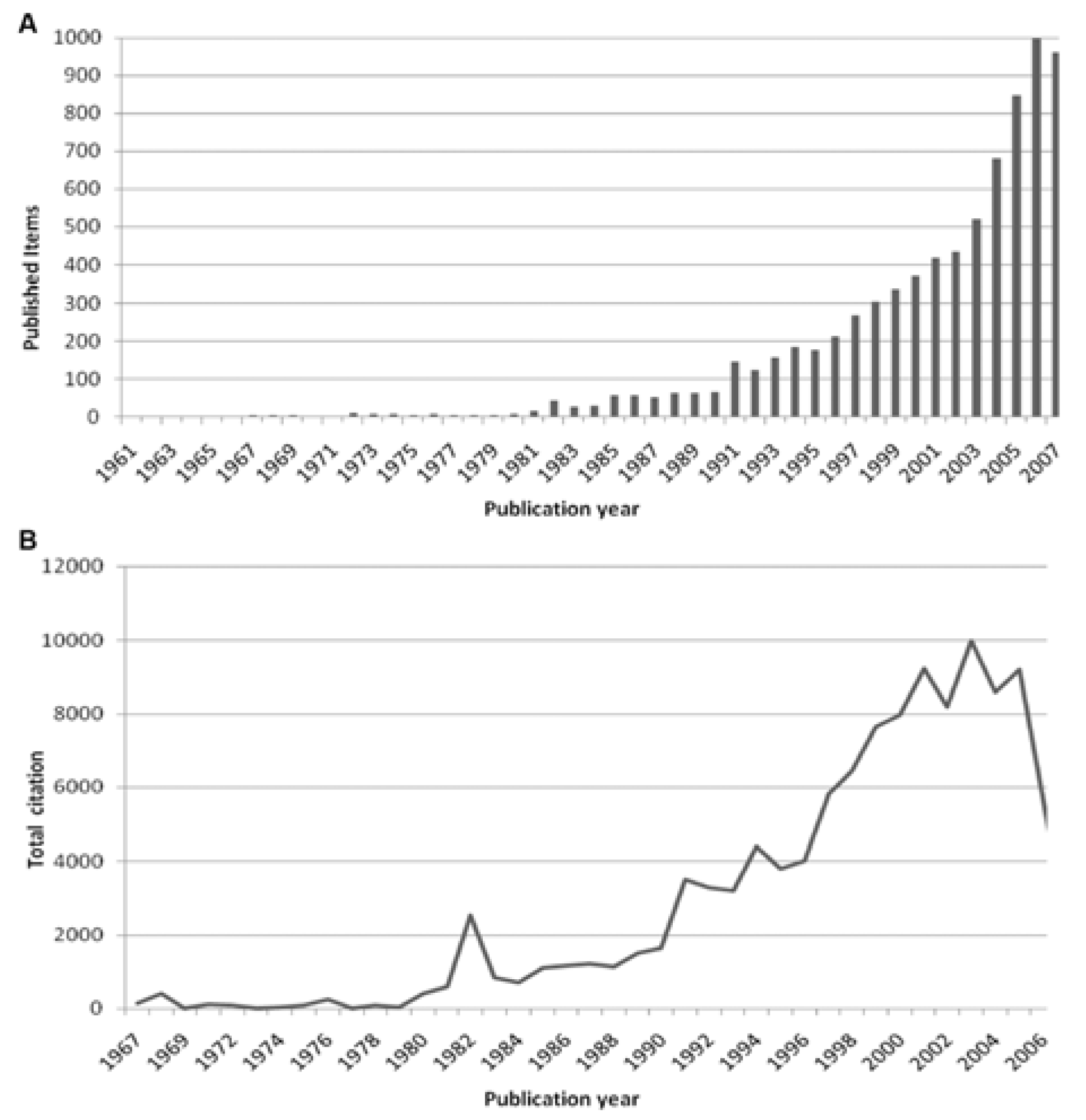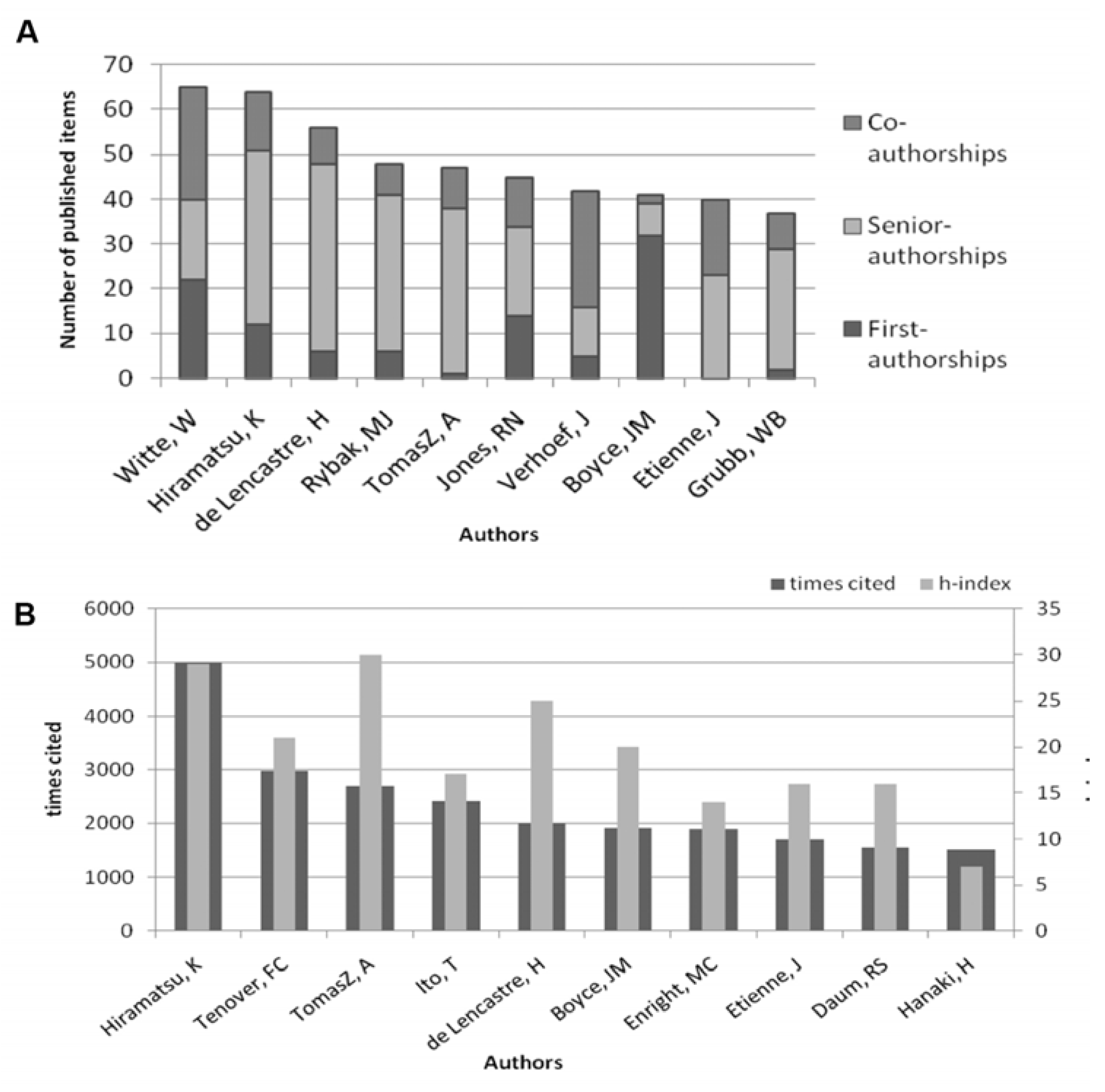MRSA: A Density-Equalizing Mapping Analysis of the Global Research Architecture
Abstract
:1. Introduction
2. Experimental Section
2.1. NewQIS-Platform
2.2. Data Source and Time Span
2.3. Search Strategies
2.4. Density-Equalizing Mapping
2.5. Quality Criteria
2.6. Analysis of International Cooperation
2.7. Journal Analysis
3. Results and Discussion
3.1. Results
3.1.1. General Parameters

3.1.2. Country Research Analysis

3.1.3. Country Research Network Analysis

3.1.4. Journal Analysis

3.2. Discussion
4. Conclusions
Acknowledgments
Author Contributions
Conflicts of Interest
References
- Wagener, J.; Seybold, U. MRSA—Hygiene management, diagnostics and treatment. Deutsch. Med. Wochenschr. 2014, 139, 643–651. [Google Scholar] [CrossRef]
- Archer, G.L.; Niemeyer, D.M. Origin and evolution of DNA associated with resistance to methicillin in Staphylococci. Trends Microbiol. 1994, 2, 343–347. [Google Scholar] [CrossRef] [PubMed]
- Lindsay, J.A. Hospital-associated MRSA and antibiotic resistance-what have we learned from genomics? Int. J. Med. Microbiol. 2013, 303, 318–323. [Google Scholar]
- Roemer, T.; Schneider, T.; Pinho, M.G. Auxiliary factors: A chink in the armor of MRSA resistance to beta-lactam antibiotics. Curr. Opin. Microbiol. 2013, 16, 538–548. [Google Scholar] [CrossRef] [PubMed]
- Gould, I.M.; David, M.Z.; Esposito, S.; Garau, J.; Lina, G.; Mazzei, T.; Peters, G. New insights into meticillin-resistant Staphylococcus aureus (MRSA) pathogenesis, treatment and resistance. Int. J. Antimicrob. Agents 2012, 39, 96–104. [Google Scholar] [CrossRef] [PubMed]
- Chua, K.; Laurent, F.; Coombs, G.; Grayson, M.L.; Howden, B.P. Antimicrobial resistance: Not community-associated methicillin-resistant Staphylococcus aureus (CA-MRSA)! A clinician’s guide to community MRSA—Its evolving antimicrobial resistance and implications for therapy. Clin. Infect. Dis. 2011, 52, 99–114. [Google Scholar] [CrossRef] [PubMed]
- Gaze, W.; O’Neill, C.; Wellington, E.; Hawkey, P. Antibiotic resistance in the environment, with particular reference to MRSA. Adv. Appl. Microbiol. 2008, 63, 249–280. [Google Scholar] [PubMed]
- Barrett, J.F. MRSA: Status and prospects for therapy? An evaluation of key papers on the topic of MRSA and antibiotic resistance. Expert Opin. Ther. Targets 2004, 8, 515–519. [Google Scholar] [CrossRef] [PubMed]
- Eady, E.A.; Cove, J.H. Staphylococcal resistance revisited: Community-acquired methicillin resistant Staphylococcus aureus—An emerging problem for the management of skin and soft tissue infections. Curr. Opin. Infect. Dis. 2003, 16, 103–124. [Google Scholar] [CrossRef] [PubMed]
- Chambers, H.F. Methicillin resistance in Staphylococci: Molecular and biochemical basis and clinical implications. Clin. Microbiol. Rev. 1997, 10, 781–791. [Google Scholar] [PubMed]
- Ito, T.; Ma, X.X.; Takeuchi, F.; Okuma, K.; Yuzawa, H.; Hiramatsu, K. Novel type V Staphylococcal cassette chromosome mec driven by a novel cassette chromosome recombinase, ccrC. Antimicrob. Agents Chemother. 2004, 48, 2637–2651. [Google Scholar] [CrossRef] [PubMed]
- Deurenberg, R.H.; Vink, C.; Kalenic, S.; Friedrich, A.W.; Bruggeman, C.A.; Stobberingh, E.E. The molecular evolution of methicillin-resistant Staphylococcus aureus. Clin. Microbiol. Infect. 2007, 13, 222–235. [Google Scholar] [CrossRef] [PubMed]
- Otto, M. Community-associated MRSA: What makes them special? Int. J. Med. Microbiol. 2013, 303, 324–330. [Google Scholar] [CrossRef]
- Hughes, C.; Tunney, M.; Bradley, M.C. Infection control strategies for preventing the transmission of meticillin-resistant Staphylococcus aureus (MRSA) in nursing homes for older people. Cochrane Database Syst. Rev. 2013, 11, CD006354. [Google Scholar] [PubMed]
- Rosenberg Goldstein, R.E.; Micallef, S.A.; Gibbs, S.G.; He, X.; George, A.; Sapkota, A.; Joseph, S.W.; Sapkota, A.R. Occupational exposure to Staphylococcus aureus and Enterococcus spp. among spray irrigation workers using reclaimed water. Int. J. Environ. Res. Public Health 2014, 11, 4340–4355. [Google Scholar]
- Groneberg-Kloft, B.; Quarcoo, D.; Scutaru, C. Quality and quantity indices in science: Use of visualization tools. EMBO Rep. 2009, 10, 800–803. [Google Scholar] [CrossRef] [PubMed]
- Groneberg-Kloft, B.; Fischer, T.C.; Quarcoo, D.; Scutaru, C. New quality and quantity indices in science (NewQIS): The study protocol of an international project. J. Occup. Med. Toxicol. 2009, 4. [Google Scholar] [CrossRef]
- Gastner, M.T.; Newman, M.E.J. Diffusion-based method for producing density-equalizing maps. Proc. Natl. Acad. Sci. USA 2004, 101, 7499–7504. [Google Scholar] [CrossRef] [PubMed]
- Tobler, W. Thirty five years of computer cartograms. Ann. Assoc. Am. Geogr. 2004, 94, 58–73. [Google Scholar] [CrossRef]
- Hirsch, J.E. An index to quantify an individual’s scientific research output. Proc. Natl. Acad. Sci. USA 2005, 102, 16569–16572. [Google Scholar] [CrossRef] [PubMed] [Green Version]
- Garfield, E. The history and meaning of the journal impact factor. Jama J. Am. Med. Assoc. 2006, 295, 90–93. [Google Scholar] [CrossRef]
- Gerber, A.; Groneberg, D.A.; Klingelhofer, D.; Bundschuh, M. Gout: A critical analysis of scientific development. Rheumatol. Int. 2013, 33, 2743–2750. [Google Scholar] [CrossRef] [PubMed]
- Gerber, A.; Klingelhoefer, D.; Groneberg, D.A.; Bundschuh, M. Silicosis: Geographic changes in research: An analysis employing density-equalizing mapping. J. Occup. Med. Toxicol. 2014, 9. [Google Scholar] [CrossRef]
- Fricke, R.; Uibel, S.; Klingelhoefer, D.; Groneberg, D.A. Influenza: A scientometric and density-equalizing analysis. BMC Infect. Dis. 2013, 13. [Google Scholar] [CrossRef] [PubMed]
- Schmidt, S.; Bundschuh, M.; Scutaru, C.; Klingelhoefer, D.; Groneberg, D.A.; Gerber, A. Hepatitis B: Global scientific development from a critical point of view. J. Viral Hepat. 2013. [Google Scholar] [CrossRef]
- Groneberg-Kloft, B.; Scutaru, C.; Kreiter, C.; Kolzow, S.; Fischer, A.; Quarcoo, D. Institutional operating figures in basic and applied sciences: Scientometric analysis of quantitative output benchmarking. Health Res. Policy Syst. 2008, 6. [Google Scholar] [CrossRef]
- Mund, M.; Kloft, B.; Bundschuh, M.; Klingelhoefer, D.; Groneberg, D.A.; Gerber, A. Global research on smoking and pregnancy-a scientometric and gender analysis. Int. J. Environ. Res. Public Health 2014, 11, 5792–5806. [Google Scholar] [CrossRef] [PubMed]
- Mund, M.; Louwen, F.; Klingelhoefer, D.; Gerber, A. Smoking and pregnancy—A review on the first major environmental risk factor of the unborn. Int. J. Environ. Res. Public Health 2013, 10, 6485–6499. [Google Scholar] [CrossRef] [PubMed]
- Bundschuh, M.; Groneberg, D.A.; Klingelhoefer, D.; Gerber, A. Yellow fever disease: Density equalizing mapping and gender analysis of international research output. Parasites Vectors 2013, 6. [Google Scholar] [CrossRef] [PubMed]
© 2014 by the authors; licensee MDPI, Basel, Switzerland. This article is an open access article distributed under the terms and conditions of the Creative Commons Attribution license (http://creativecommons.org/licenses/by/4.0/).
Share and Cite
Addicks, J.P.; Uibel, S.; Jensen, A.-M.; Bundschuh, M.; Klingelhoefer, D.; Groneberg, D.A. MRSA: A Density-Equalizing Mapping Analysis of the Global Research Architecture. Int. J. Environ. Res. Public Health 2014, 11, 10215-10225. https://doi.org/10.3390/ijerph111010215
Addicks JP, Uibel S, Jensen A-M, Bundschuh M, Klingelhoefer D, Groneberg DA. MRSA: A Density-Equalizing Mapping Analysis of the Global Research Architecture. International Journal of Environmental Research and Public Health. 2014; 11(10):10215-10225. https://doi.org/10.3390/ijerph111010215
Chicago/Turabian StyleAddicks, Johann P., Stefanie Uibel, Anna-Maria Jensen, Matthias Bundschuh, Doris Klingelhoefer, and David A. Groneberg. 2014. "MRSA: A Density-Equalizing Mapping Analysis of the Global Research Architecture" International Journal of Environmental Research and Public Health 11, no. 10: 10215-10225. https://doi.org/10.3390/ijerph111010215



